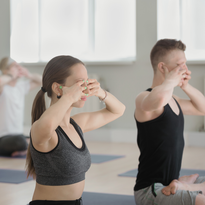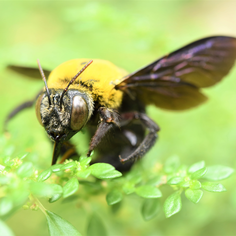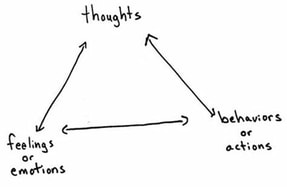|
6/2/2023 0 Comments Do This Simple Breathing Exercise Anywhere to Regulate Emotions and Train Smarter Figure Skaters practice the Bee's Breath (Brhramari) Pranayama as part of their off-ice training Figure Skaters practice the Bee's Breath (Brhramari) Pranayama as part of their off-ice training You’re on a crowded session with the music blaring, and no one seems to be paying attention. You are stressed over schoolwork and are starting a new job this weekend, too. You just really, really wanted to work on your lutz (single, double, or triple?) this session, but a beginner keeps spinning in the lutz corner and a group of teens is full-on procrastination via socialization in the other. When you finally spot an opening to put a jump up, you’re already so agitated that the attempt turns into a massive flop. You need a quick exercise to get you back on track before trying again. Sure, a jump drill sometimes helps redirect your thoughts, but this agitation you’re feeling at this moment isn’t technical. It’s physiological…. Tightness in the chest, shallow breathing, tense shoulders, legs on the ready. Like a cat ready to pounce on its prey, you are ready to pounce into the opening in the traffic for that jump. Except… you are attempting a very technical skill that requires full-body coordination. And you must land on an ice knife with beauty and precision. Skating should be your happy place, not the source of your stress! There are simply too many stimuli! If only you could just block out the chatter, slow the breath, relax the shoulders, and calm the racing thoughts. The Bee’s Breath (Bhramari) technique - can help. Train Smarter Using Pranayama in Your Off-Ice TrainingWe all have bad habits, emotions, and negative thought cycles that interfere with our training. Doubt, fear, jealousy, and frustration, as well as outside stressors all affect our mind, body, and spirit and can interfere with choices that we make on and off the ice relating to our skating–in the moment and sometimes even long-term. We all know that training smarter and skating better helps us enjoy the entire learning process and skating journey more. Training smarter doesn’t mean that difficult moments and periods won’t arise… it just means that we use techniques and skills to avoid some of the mental nonsense that leads to bad habits. So how do we train smarter? In a previous article, I talked about three habits almost all skaters show at some point that are harmful to their mental, emotional, and even physical well-being. (There are others, but for the sake of space, I narrowed it down to three that I see most often) The only way we can stop harmful thoughts and behaviors is to first be aware of them, avoid them, and replace them with something more positive. Actually implementing the new habits takes practice, discipline, and time. Exactly how much depends on the habit and the person. (Between 18 and 254 days, according to this popular study from the European Journal of Social Psychology.) There are lots of techniques taught in psychology to redirect thoughts and behaviors (this is the basis of the cognitive triangle), and I have written about some of them before. Different techniques work better for different people and in different situations, but the premise is the same–when you find yourself in a downward spiral, you need a positive thought or action to change the direction of the spiral to bring the thoughts, feelings, and actions back into a more positive direction. One of my favorite types of interventions in these scenarios involves breathwork, and specifically pranayama. Why Figure Skaters Need to Practice Breathing ExercisesPranayama is the fourth limb of the 8 limbs of yoga, mentioned in verse 2.29 of Patanjali’s Yoga Sutras. (visit here for a complete diagram of the 8 limbs and their application to skating) The word pranayama comes from the Sanskrit words prana, meaning “life force energy” and yama, which means “control”. According to the authors of “Effects of Bhramari Pranayama on health – A systematic review”, the term pranayama literally means: “a yogic act performed for controlling the flow of vital energy that governs all the physiological processes in the body”. In other words, pranayama involves controlling one’s breath in different styles, lengths, and techniques to achieve various physiological effects in the body. Different factors, stressors, and patterns in our daily lives can lead us into shallow, irregular breathing patterns which can lead to long-term emotional, mental, and even physical problems. The most common example of this is how shallow breathing can cause the same effects in the body as anxiety and stimulate the sympathetic nervous system (fight or flight response). Pranayama practices work to counteract less-than-ideal breathing patterns and even some illnesses. Sounds weird, and some techniques are very advanced and have many contraindications, but some techniques are quite simple and safe for most people. Specific techniques have shown promise in helping patients with COPD , and many practices have been proven to lower blood pressure. Other techniques are designed to stretch and strengthen the diaphragm and/or the intercostal muscles, which is especially beneficial for skaters. And all are known to decrease anxiety and depression, boost mood and energy, and improve focus. A consistent pranayama practice of 5-7 minutes a day is enough to get in the habit and strengthen proper breathing patterns, which can improve mental health, our stress response, and the ability to breathe properly in a skating program when it counts. The Bee's Breath - A Simple Exercise to Help Skaters Train Smarter and Skate Better The sound made during the Bee's Breath - Bhramari - Pranayama mimics the humming of the bee The sound made during the Bee's Breath - Bhramari - Pranayama mimics the humming of the bee One specific technique skaters can include or use as their pranayama practice is called Bhramari. It’s a humming breath practice named after the black bumblebee in India. (In Sanskrit bhramara means “big black bee”.) Bhramari is one of the pranayama techniques mentioned in the 15th-century authoritative yoga text the Hatha Yoga Pradipika We don’t need to approach the camel spin with as much stress as being chased by a tiger, but sometimes the body’s stress response is triggered anyway. The discomfort of trying to perform something new can stress us out before we even realize it. Using a technique such as the Bee’s Breath can interrupt that stress response before it causes a downward spiral and bring us back into balance so that we can train smarter and learn more effectively. There are other benefits to Bhramari, too, besides just being a technique to intervene in the cognitive triangle. In fact, these benefits are why it is such an effective intervention! Some of these many benefits are:
I like to teach Bhramari to skaters because it’s easy to learn – everyone knows how to hum - and fun to practice. It doesn’t require counting or any confusing patterns of repetition. Children enjoy pretending they are bees, and when practiced in a class together, it can bring a very powerful, unifying energy to the room. The vibrations of bhramari are very soothing, like stimming or mantra repetition and are good for practicing the fifth limb of pratyahara (withdrawal of the senses) and the sixth limb of dharana (concentration). Bhramari can be practiced anywhere discreetly and with gloves on, as opposed to some other types of pranayama which often require placing the hands over the nose (who wants to do that dirty skating gloves on?) There’s no need to worry about what other people are thinking when you take a deep breath and begin to hum because no one can hear you over the music in the rink, anyway! "The discomfort of trying to perform something new can stress us out before we even realize it. Using a technique such as the Bee’s Breath can interrupt that stress response before it causes a downward spiral and bring us back into balance so that we can train smarter and learn more effectively. " How to Practice the Bee's Breath Off-Ice and On-IceJust like you often learn jump technique and jumps off ice before trying them on ice, I recommend first practicing Bhramari at home, where you will have less distractions.
To practice off the ice:
To practice at the rink:
There are many techniques to intervene in the cognitive triangle during practice and help skaters improve stress response. However, the unique nature of bhramari pranayama– a combination of breathwork (pranayama) and chanting meditation (dharana) – means that it is an especially effective off-ice training tool for figure skaters, as it has many proven benefits to mental, emotional, and physical health. And because it is so simple to practice–what child doesn’t know how to hum??–it is be a very important tool for helping skaters train smarter, skate better, and enjoy the process. Get more tips to replace your harmful habits on the ice with helpful ones with my FREE GUIDE: Anti-Anxiety Tools for Skaters.
0 Comments
Leave a Reply. |
Author // the skating yogiMy name is Sarah Neal. I have been immersed in the world of figure skating for over four decades. I have seen firsthand the abuse that happens at the higher levels of our sport and experienced how that trickles down into unhealthy training practices and habits at the grassroots. I have seen this play out in the operations of the very institutions that control our sport. Whether for a profession or hobby, pursuing skating should be a joyful, rewarding process, an opportunity for athletic and personal growth, and a place to build lasting friendships. Archives
March 2024
CategoriesAll Athlete Well Being Athlete Well-Being Deep Connections Embodied Movement And Meditation Practices Life After Competition Mindful Living |
Search by typing & pressing enter


 RSS Feed
RSS Feed